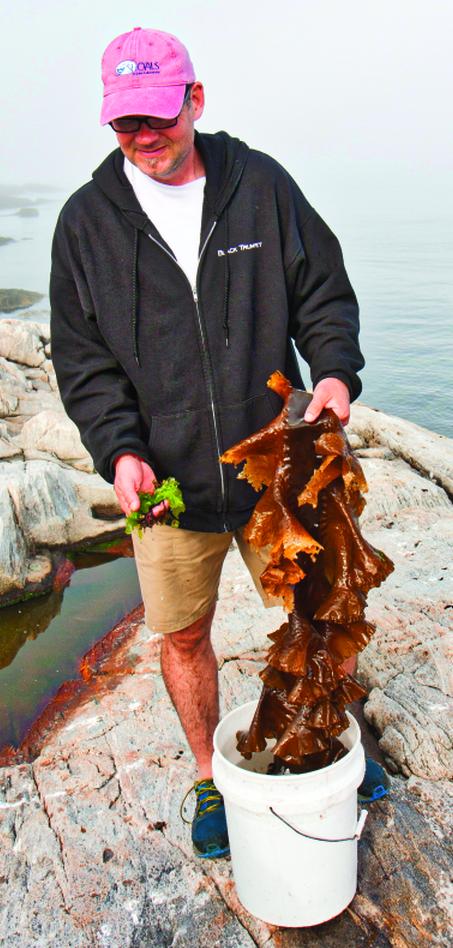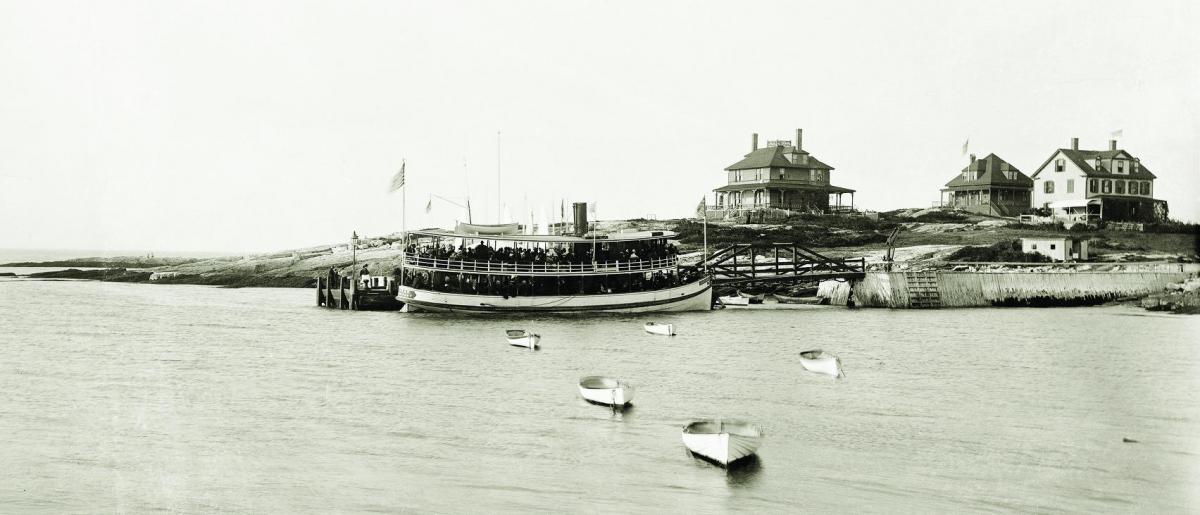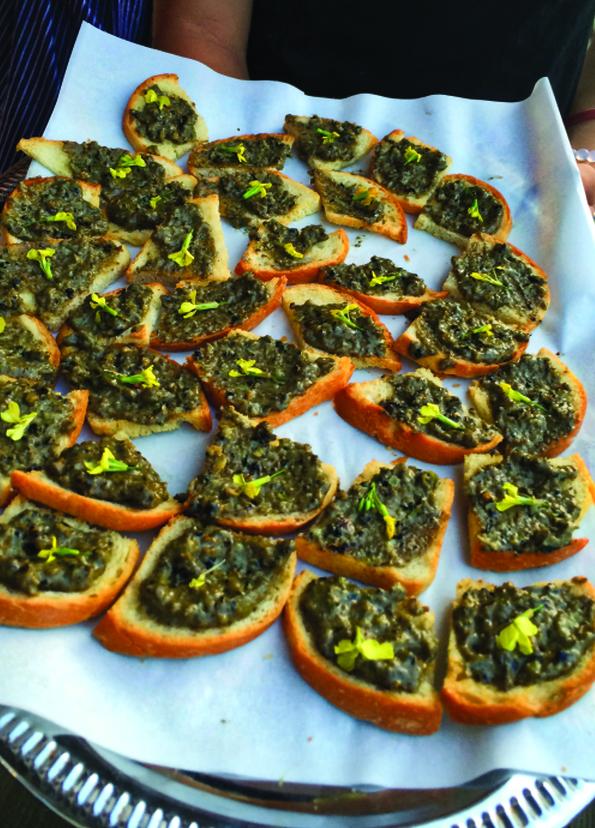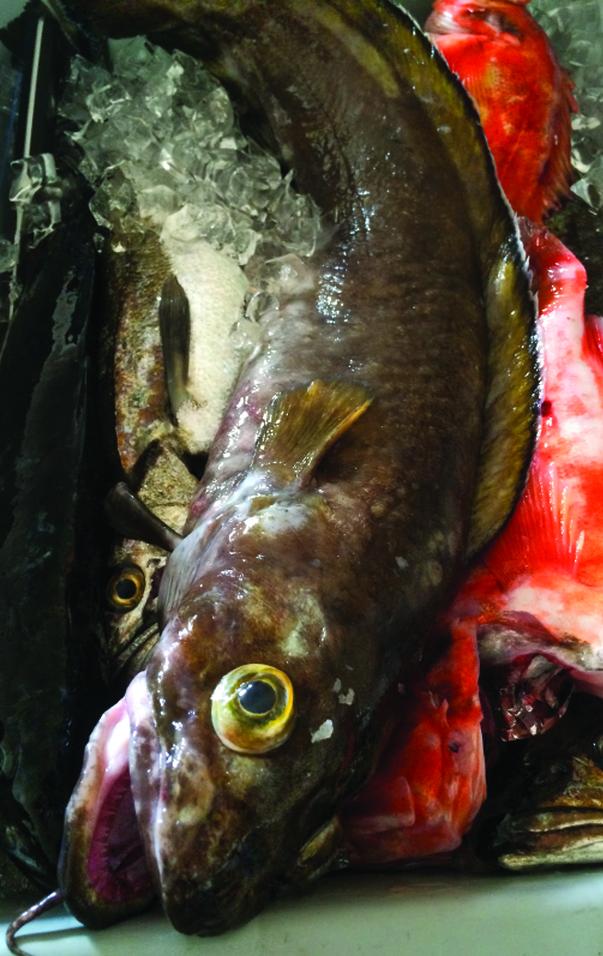At a little less than 700 feet above sea level, Mt. Agamenticus is not much of a mountain. Still, solitary Agamenticus dominates the flat skyline of southern Maine. From the top on a clear day, they say you can see all the way from snow-capped Mt. Washington in the north to the distant Isles of Shoals. I like to imagine Abenaki people perhaps a thousand years ago, perhaps even longer, spying those islands on the horizon and setting off in their fragile bark canoes to see what they could find.
 The Shoals Marine Lab on Appledore Island looks out toward the coast of New Hampshire and Maine in the distance. Photograph courtesy Jeremy Gasowski/Univ. of New Hampshire
The Shoals Marine Lab on Appledore Island looks out toward the coast of New Hampshire and Maine in the distance. Photograph courtesy Jeremy Gasowski/Univ. of New Hampshire
 Chef Evan Mallett of Black Trumpet Restaurant in Portsmouth holds a large piece of fresh kelp. Photograph courtesy Jim Coyer/Shoals Marine LaboratorySome people think of islands, like mountains, as barriers at the edges of the known world. I think of them instead as sirens, luring us to venture beyond, to see what lies on the other side. The Abenaki could be daring explorers, full of curiosity about their world and what lay beyond it. So it’s not surprising that, after years of skepticism, clear evidence has emerged from recent excavations on Smuttynose, one of the largest of the islands, that Native Americans did indeed camp on the Isles of Shoals long before European fishermen showed up there in the early years of the 17th century. Those first people left behind stone points, knives, and scrapers, along with telltale bits of pottery, all indications that they came for the same reason the fishermen did, in search of the ocean’s bounty. Is it any wonder then, that another stunning piece of evidence from the excavations on Smuttynose was the huge vertebra of a giant cod, one estimated to have weighed, alive, 150 pounds. Some fish!
Chef Evan Mallett of Black Trumpet Restaurant in Portsmouth holds a large piece of fresh kelp. Photograph courtesy Jim Coyer/Shoals Marine LaboratorySome people think of islands, like mountains, as barriers at the edges of the known world. I think of them instead as sirens, luring us to venture beyond, to see what lies on the other side. The Abenaki could be daring explorers, full of curiosity about their world and what lay beyond it. So it’s not surprising that, after years of skepticism, clear evidence has emerged from recent excavations on Smuttynose, one of the largest of the islands, that Native Americans did indeed camp on the Isles of Shoals long before European fishermen showed up there in the early years of the 17th century. Those first people left behind stone points, knives, and scrapers, along with telltale bits of pottery, all indications that they came for the same reason the fishermen did, in search of the ocean’s bounty. Is it any wonder then, that another stunning piece of evidence from the excavations on Smuttynose was the huge vertebra of a giant cod, one estimated to have weighed, alive, 150 pounds. Some fish!
Smuttynose is one of nine rocky, nearly treeless islands that make up the Isles of Shoals, a mini archipelago some eight or nine miles off the coast of southern Maine and New Hampshire. The islands are divided between the two states, with Maine claiming Smuttynose and neighboring Appledore (which is the largest of the group, at 95 acres), as well as little Cedar, which is connected to Smuttynose by a breakwater, and Duck Island, away to the north, once used as a bombing range by the U.S. Navy and now a protected bird and seal sanctuary. The other islands are in New Hampshire, including Star, with a resort run by the Unitarian Universalist Church, and White, with its dramatic 58-foot-tall lighthouse.
The three principal islands, Appledore, Smuttynose, and Star, form a protective arc around Gosport Harbor, a fine overnight shelter for yachts today, just as it once was for a fishing fleet that numbered at times in the hundreds of boats.
The archipelago is a gatekeeper to the fishy riches of the Gulf of Maine. That was one reason why I went out to Appledore late last summer with a group of 20 or so like-minded folk. We hoped to learn how this natural bounty might fit into the future of our food. I had felt the lure of the islands for many years and jumped at the chance to see for myself what was out there.
 During Appledore’s heyday as a resort, visitors arrived by steamboat. This image, showing the steamer E.P. Shaw, was an early postcard, printed by the Eastern Illustrating Co. of Belfast, Maine. Courtesy Penobscot Marine Museum
During Appledore’s heyday as a resort, visitors arrived by steamboat. This image, showing the steamer E.P. Shaw, was an early postcard, printed by the Eastern Illustrating Co. of Belfast, Maine. Courtesy Penobscot Marine Museum
The program I attended was crafted jointly by the Shoals Marine Lab and two restaurant chefs, Evan Mallett of Black Trumpet in Portsmouth, New Hampshire, and Sam Hayward of Fore Street in Portland, Maine. Both chefs are known for their commitment to sustainability. Joined by scientists and historians, our group spent the weekend foraging the rocky shoreline and the intertidal zones, studying bird life (both the ever-present gull colony and the fall and spring migrations), casting wide nets (trawling, actually) into surrounding waters to see what would come up, questioning, opinionating, cooking, and eating, all the time acquiring and exchanging information and understanding.
Shoals Marine Lab is a remarkable institution, and its director Jennifer Seavey is rightly proud of what gets accomplished there. Jointly run by the University of New Hampshire and Cornell University from headquarters on Appledore, it is a summer field station for marine science research and education. While the focus is marine biology, the true aim is the education of future scientists. Students arrive in groups of 20 for two intensive weeks—so intensive that a successful completion of a two-week program carries a full semester’s worth of credit from Cornell.
 Crostini topped with periwinkle butter, an antipasto created by chefs Evan Mallett of Black Trumpet and Sam Hayward of Fore Street Restaurant in Portland. Photograph courtesy Carol SteingartThe programs touch on all aspects of maritime science from environmental studies to evolution, from ornithology (the island is home to large protected colonies of black-backed and herring gulls) to the biology of sharks and skates, from genetics to invertebrate biology in the intertidal zone, and from problems of sustainable fisheries to the peculiar demands of underwater research. One specialized program, given the unique problems of living on a remote island, is in sustainable engineering, as the entire institution has become almost fully reliant on renewable power. Just a few years ago, the lab consumed 10,000 gallons of fuel annually; in early September of this past year, Seavey proudly announced, they were only at the 1,000-gallon mark for the entire year.
Crostini topped with periwinkle butter, an antipasto created by chefs Evan Mallett of Black Trumpet and Sam Hayward of Fore Street Restaurant in Portland. Photograph courtesy Carol SteingartThe programs touch on all aspects of maritime science from environmental studies to evolution, from ornithology (the island is home to large protected colonies of black-backed and herring gulls) to the biology of sharks and skates, from genetics to invertebrate biology in the intertidal zone, and from problems of sustainable fisheries to the peculiar demands of underwater research. One specialized program, given the unique problems of living on a remote island, is in sustainable engineering, as the entire institution has become almost fully reliant on renewable power. Just a few years ago, the lab consumed 10,000 gallons of fuel annually; in early September of this past year, Seavey proudly announced, they were only at the 1,000-gallon mark for the entire year.
One major goal of this buzz of summer activity is the collection of data. The Gulf of Maine is warming more rapidly than almost any other ocean region on earth, with possibly dire consequences for everything from lobster pots to blueberry barrens. Indeed, the whole gulf has been called “a living laboratory” for how marine ecosystems around the world might react to climate change.
“We’re building up a long-term database,” Seavey explained to me. “We have 40 years of data, for instance, on intertidal marine organisms.” Documenting the history of fishing on the islands is another piece of the puzzle. “Putting it together with data sets from current observations helps with the reconstruction of the marine ecology of the Gulf of Maine. All this shows the signatures of climate change, the changing ecology of an island community over time.” When Seavey refers to an island community she means the entire community, including people, animals, and plant life, everything that lives and works together in a pattern of mutual sustenance and competition.
The 20-odd paying guests who came along last September were a motley crew of chefs, food writers, bloggers, television cooks, food historians, and Slow Fish advocates—folks involved in the food business one way or another and all deeply concerned about the sustainability of the food resource we depend on. We had come to Appledore to learn and to taste. We began with a rugged tour of the island, circumnavigating it to get a sense of place, of what grows well (lots of poison ivy) and what does not (apple trees, stunted by wind, yield spare harvests), of how rock ledges and cobble beaches relate to marshes and meadows, a sense of what one member of the group deemed “a rare Maine island that has gone backwards in time.”
As indeed it has. In the 17th and 18th centuries, there were somewhere between 600 and 1,000 permanent inhabitants, mostly fishermen and their families, on these islands. Their free-living habits were the despair of Massachusetts Bay Puritans. In the mid-19th century Thomas Laighton, formerly lighthouse keeper on White Island, bought Hog Island, renamed it Appledore, and opened the Appledore Hotel, a popular resort that could accommodate 500 guests, including notables such as Nathaniel Hawthorne, William Dean Howells, John Greenleaf Whittier, and the artists William Morris Hunt and Childe Hassam. Hard to imagine how Laighton and his daughter Celia Thaxter, one of America’s best-loved poets who oversaw a prestigious salon at the hotel, could provision for that number when almost nothing grew on the island in the quantities necessary to produce all those meals. Today there are no permanent residents on Appledore; when the lights go out at the end of September, they stay out until the following May.
As for the provisions, I can’t testify to what the scientists consume on the island, but our meals that weekend were provided by Hayward and Mallett, two of the coast’s star chefs, assisted by island chef Charlotte Ott. Instead of dazzling us with exotic ingredients and techniques, however, our chefs stuck close to the parameters of what was available, drawing from period literature such as Maria Parloa’s Appledore Cookbook, published in 1872, to give us something like what Appledore guests might have supped on in the heyday of the resort. Our dinner on the rocks, almost inevitable in late summer anywhere on the coast of Maine, included, in addition to the usual lobsters and clams, both whelks, tasty trash gastropods that deserve greater popularity, and seaweeds, a new coastal food enterprise, served in various forms including slaw, which was surprisingly refreshing. (For more about cooking with whelks, see my previous article “Whelks, Anyone?” in MBH&H #131, Boat Show Issue 2014.) Another feature of the shore dinner was saddle oysters, a bivalve that’s also occasionally called by the charming name mermaid’s toenails. “The flesh,” I am advised by no less an authority than Wikipedia, “is distastefully bitter and is not eaten.” Tell that to Mallett and Haywood, Wiki! These were delicious.
We had arrived with the green corn moon, according to John Forti, a botanical historian with the Massachusetts Horticultural Society who led a tour to identify useful plants, medicinal and culinary, native and introduced, many of which those earliest settlers knew well. “Plants tell you about the landscape and who was here,” Forti said, “but they also tell you what local economies can yield.” Everything had a purpose and could have a purpose once again—sumac, St. John’s wort, mullein, purslane, sorrel, and sea rocket. “They didn’t call them weeds,” he added, “because they knew a use for them.”
This was one of the weekend themes—that what people used to do, what we have lost over the years, can be restored, brought back to life, to the benefit of our own health and ultimately the health of the earth. Today the most innovative science often consists in looking backward at older models for organic and sustainable practices.
The next day we took the battle for the environment right into the kitchen with fried green crabs. These voracious scavengers feed on clams, mussels, even baby lobsters; recent invaders, they have become a troublesome scourge for local fishing efforts. But deep-fried they were crisp, crunchy, and delicious—the goal of the operation was to encourage over-fishing of the insatiable intruders, quite simply to wipe them out.
 A fresh cod and redfish ready to be used as ingredients for a meal. Photograph courtesy Carol SteingartA sense of a place, unique, irreparable, at times indefinable, is what Appledore gives to those who venture there. Chef Hayward said he still feels it strongly, ever since he began his kitchen career as chief cook on the island back in 1974 in the early days of the field station. Hayward and his wife Jan (a registered nurse, she was very much needed on the remote outpost), along with their friend the artist Cynthia Hyde, provided for the scientists, students, and intern participants. They returned every summer for the next three years. “There was a sense that we were building something,” Hayward said. “We had fishing boats calling in here all the time, small rigs out of Gloucester that were trawling Stellwagen and the Banks. We’d buy the top of the catch and pull it right into the kitchen where the students would get to work cutting and dissecting. We wanted the fish intact so we could examine the organs, linking food and ecology. Those were 40-pound cod—you don’t get them that size any more.” It was a way of thinking, he said, about how everything is ultimately connected. “If cod go into decline, what effect will that have on the lobster population? There was a magic about the experience,” he went on, “that I’ve tried to capture in other parts of my life since then.”
A fresh cod and redfish ready to be used as ingredients for a meal. Photograph courtesy Carol SteingartA sense of a place, unique, irreparable, at times indefinable, is what Appledore gives to those who venture there. Chef Hayward said he still feels it strongly, ever since he began his kitchen career as chief cook on the island back in 1974 in the early days of the field station. Hayward and his wife Jan (a registered nurse, she was very much needed on the remote outpost), along with their friend the artist Cynthia Hyde, provided for the scientists, students, and intern participants. They returned every summer for the next three years. “There was a sense that we were building something,” Hayward said. “We had fishing boats calling in here all the time, small rigs out of Gloucester that were trawling Stellwagen and the Banks. We’d buy the top of the catch and pull it right into the kitchen where the students would get to work cutting and dissecting. We wanted the fish intact so we could examine the organs, linking food and ecology. Those were 40-pound cod—you don’t get them that size any more.” It was a way of thinking, he said, about how everything is ultimately connected. “If cod go into decline, what effect will that have on the lobster population? There was a magic about the experience,” he went on, “that I’ve tried to capture in other parts of my life since then.”
Late the first afternoon we settled on ledges looking out at Smuttynose and toasted the view with welcome bottles of chilled Smuttynose beer, one of New Hampshire’s great contributions to gastronomy. Seavey pointed out a small island to the south that was part of the chain. “That’s Seavey,” she said. “It was named for my eight times great-grandfather—a fisherman out here in 1620. From the Abenaki to the fishermen to the 19th century romantics to the scientists today—what draws them always is this sense of the place.”
I went out to Appledore with a lot of questions. I left with even more—questions about ocean warming and acidification, about the effects of climate change on marine life, especially the kinds of fish and seafood we’ve come to expect on our tables, whether humble cod or elegant lobster. The Gulf of Maine, Erik Chapman had told me, is one of the most sustainably managed fisheries in the world. This surprised me, but Chapman, who accompanied us on our trawling expedition, is New Hampshire Sea Grant’s fisheries program coordinator.
He along with the other experts we encountered on Appledore are not ready to give up on their search for the answers, and that gave me confidence that these are not insoluble questions, even though they require hard work and hard decisions. And not least the devotion of everyone connected with the Shoals Marine Laboratory.
Asian Seaweed Salad
This recipe comes from Evan Mallett, chef at the Black Trumpet Restaurant in Portsmouth, New Hampshire, and will be included in his forthcoming book from Chelsea Green Publishing.
Ingredients:
2-foot length of sugar kelp (about 3½ ounces)
3 oz. fresh alaria
3 oz. fresh dulse
1½ ounces fresh sea lettuce (Ulva lactuca)
1/2 head Napa cabbage
6 leaves of lacinato kale, aka Tuscan kale
2 large carrots
1 red onion
2 jalapeno chiles, ribs removed
2 scallions
3 Tbsp. roasted sesame oil
1/2 cup rice vinegar
2 Tbsp. agave nectar (or honey)
Juice of one lime
Juice of one orange
Salt and pepper to taste
Togarashi for garnish
Directions:
Chop the leaves of all the seaweeds except the sea lettuce into very thin strands. Bring a quart of water to boil in a small pot. Prepare an ice bath next to the stove. One at a time, dip each seaweed variety in boiling water for about fifteen seconds. Remove to an ice bath until cool, then shake off excess moisture and transfer to a large bowl. Repeat until all the seaweed is blanched.
Sliver the carrot and the cabbage on the finest blade of a Japanese mandolin slicer, or—using a very sharp knife—slice into the thinnest possible ribbons.
Strip the kale leaves away from the stems, discarding the stems. Roll up the leaves tightly and slice crosswise into thin strips. Slice the onion and jalapeño very thin. Cut scallions on a long, thin bias.
In a large mixing bowl, whisk together the oil, vinegar, nectar or honey, citrus juices, and salt and pepper. Toss all the vegetables in the dressing until they are thoroughly coated. Portion salad and serve with a sprinkle of togarashi on top of each serving.
Serves 8 to 10 people.
Sea vegetables thrive in our coastal waters. If you are working with freshly harvested seaweed, be sure to rinse it well and pick through for any unwanted visitors to your salad. If you don’t want to take the time to snorkel for your dinner, seaweeds can be bought dried, then boiled until tender, and chopped into very thin strips.
Sea vegetables, or seaweeds, fresh and/or dried, can be ordered from the following suppliers: www.seaveg.com; www.theseaweedman.com; www.ironboundisland.com; www.atlanticholdfast.com; www.oceanapproved.com.
The fish sauce, rice vinegar, and togarashi can be found online or at Asian markets. Converting from fresh to dried seaweed is not a perfect science, but in most cases, a ratio of 10-to-1 works.
Salt Cod Cakes
This recipe comes from Sam Hayward,
chef at Fore Street Restaurant in
Portland, Maine.
Ingredients:
1 lb. salt cod filet
1 lb. peeled potatoes, preferably floury russet type, weighed after peeling
1 large egg, beaten
Fresh milled black pepper to taste
A pinch of cayenne pepper
1 oz. salt pork belly or fat back, rinsed in cool water
Peanut oil for frying
Dehydrated potato flakes for coating
Directions:
Soak the salt cod filet overnight or for eight hours in at least three changes of cool water. Remove from its soaking bath and strip away the skin if necessary (not all cod filets come with the skin attached). Run your hands over the filet to detect any bones and remove them with tweezers or small pliers. Cut the filet into 1-inch pieces.
Bring about 1/2 inch of water to simmer in the bottom of a saucepan and add the salt cod pieces. Cover and steam, just until the fish flakes easily when probed with a fork, about four or five minutes, depending on the thickness of the filet. Drain the fish when done.
Cook the potatoes in barely simmering water until tender. Drain thoroughly and use a potato masher to crush into a coarse mash while still hot.
Flake the fish gently and add to the potatoes. Season with black pepper and a pinch of cayenne pepper to taste, then fold the fish and potatoes gently together to combine. Cool slightly, and fold in the beaten egg.
Cut the pork into 1/4-inch dice. Add to a wide skillet and cook over moderate heat to render some of their fat and gently brown the pieces. Remove the pork pieces with a slotted spoon and reserve them. Do not discard the fat in the pan.
Form the fish and potato mixture into small cakes about 2 inches round and
1/2 to 2/3 of an inch high. Spread the potato flakes out on a plate.
Add enough oil to the fat in the skillet to film the entire bottom of the pan, and increase the heat until a slight shimmering can be seen above the oil. Press both sides of the cod cakes into the dehydrated potatoes, and set them gently into the hot fat. Moderate the heat so that the surfaces brown gently without scorching, cooking about 3 minutes on each side.
Serve hot, scattering the reserved salt pork pieces over the cakes.
An old-fashioned egg sauce (béchamel with chopped hard-cooked eggs, and chopped fresh parsley or chives) would be a taste of history.
Other accompaniments could be a mayonnaise with chopped salt-herbs, a pickle sauce like a remoulade, or brown butter with capers and lemon.
Note on potatoes: The variety should be more floury than waxy. I use Grandson Farm’s (Dresden, Maine) Keuka Gold, a yellow medium-floury all-purpose variety.
Nancy Harmon Jenkins is the author of many books and contributor to a number of publications including The Wall Street Journal and Saveur. Her most recent book is Virgin Territory: Exploring the World of Olive Oil (Houghton Mifflin Harcourt, 2015). She lives in Camden and Tuscany.
To learn more about the public education programs for adults and children, including a walking tour of Appledore Island, visit the Shoals Marine Laboratory website: www.shoalsmarinelaboratory.org.






